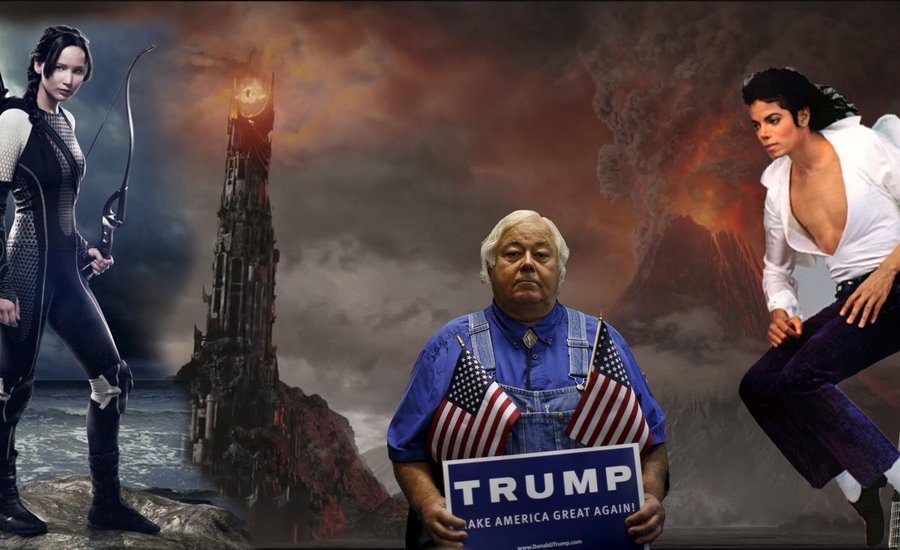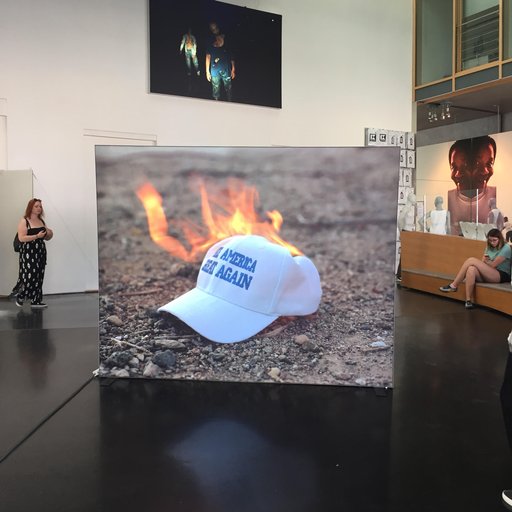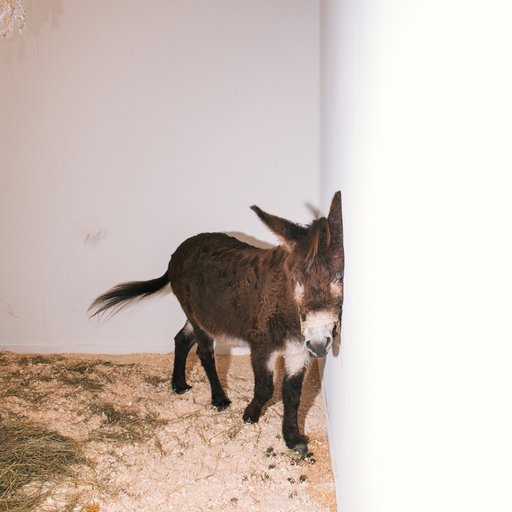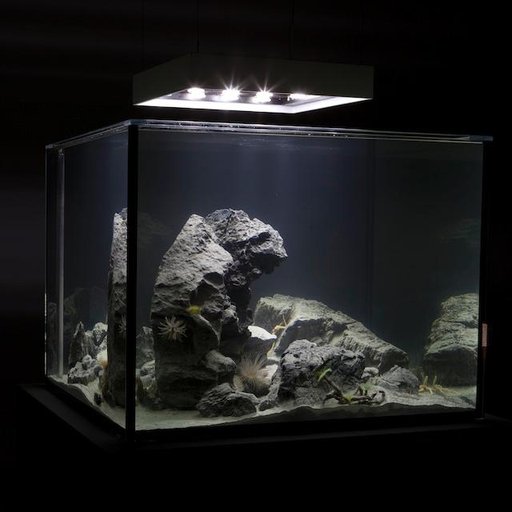The dawning of a new year is always an occasion for reflection on one's place in the world, and resolutions to do better in the coming cycle. This year, because of the uncannily hideous and destabilizing nature of 2016, these contemplations are a heavy lift indeed. And for those of us who make, sell, buy, display, and write about artworks—who for so long have floated safely atop the cream cap of global wealth—they might require a few radical reassessments.
What are we to make of the threats to our nonwhite, non-heteronormative friends who make society and its art so diverse, as we saw come home to the New York art world's doorstep when Trump supporters viciously attacked LGBTQ activists as they were leaving Artists Space two weeks ago? What are we to think of art-world activism like the Dear Ivanka protests, where artists in Ivanka Trump's personal collection took to both Instagram and the streets to shame the first daughter by drawing a contrast between her cosmopolitan lifestyle and her politics? What are we supposed to do with ourselves, and our endless resources of creativity and imagination?
Let's think this through together. Here, as an opening volley to welcome bright and shining 2017, are six questions we can start asking ourselves.
HOW LIBERAL IS THE ART WORLD, REALLY?
A few weeks ago, at a press luncheon to announce Los Angeles’s next Pacific Standard Time art festival, titled “LA/LA,” LACMA director Michael Govan explained the intention to celebrate his city’s longstanding interconnection with Latin America. “California was once part of Mexico, and may be again,” he said, eliciting chuckles. “We want to build bridges. We want to erase borders. Can I say this so close to 5th Avenue?” The venue, Michael’s, was a few blocks from Trump Tower. “I know you’re all with me,” he smiled. But are we?
There is a cornucopia of assumptions about the liberal cast of the art world. The reasoning goes that most artists, free-thinkers that they often are, support progressive social and political mores; therefore the critics and journalists attracted to writing about these artists probably share their values; same with dealers who want to work with them; ditto the collectors who buy the art. All are happy followers of the “liberal arts,” so called because since ancient times an appreciation for culture has been considered an indispensable background for a free parson to participate in the public discourse. Everyone, ethically and morally, is on the same page.
But somewhere along the line this logic, so central to warm-and-fuzzy “us” of the art world, broke down. Once, perhaps, the contemporary art world was composed of small, more or less local communities of struggling creatives who scraped along by helping one another and relying on the munificence of the occasional wealthy doyenne (who typically had bohemian leanings). But, for a while now, that art world has really been an art industry, vast and global in scope, epitomized by mega-galleries with dozens of employees and multiple locations, and patronized by the winners of the global economy who see new artworks as the ultimate status-boosting luxury commodity.
Sometimes, these are financiers and flippers whose chief aesthetic interest is how well an extra zero would look on their new artwork/asset’s price tag; sometimes, the glamorous moneymen and women at the top of this pyramid are aligned with the most conservative powers-that-be. Look at Russia’s buzziest art institutions. Look at Trump Tower, where members of the powerful Mugrabi, Nahmad, and Gmurzynska art-broker families live.
Nothing guarantees that these dominant forces in the art community are liberal behind closed doors, beyond the remit of a fancy art party. As one very plugged-in art advisor put it, “Many board members and trustees of museums lean far right in terms of party economic agenda, so the short-term values of one's pocketbook are one thing, and the long-term values of voting for social agenda is another thing. As the old saying goes, “That's why they call it 'show business' and not 'show friends.’”
Buying art in these cases can be the equivalent of buying carbon offsets, paying lip service to liberal values while propagating anti-liberal practices. This is not new, and this is not secret. Everybody knows it. To pretend otherwise, and take comfort in the notion that today’s art business is somehow inherently progressive (particularly at the financial level where it really matters), is the biggest hypocrisy.
WHY DID ARTISTS BECOME ARTISTS IN THE FIRST PLACE?
Looking back at 20th-century art history, it’s easy to view artists as vital change agents, opening society’s eyes to revolutionary new ways of seeing the world and their possibilities within it. There were great figures like Picasso and and Malevich and Oiticica who rocketed from one breakthrough to another, fueled by unceasing supplies of ambition. Ideas mattered, political issues were at stake, and the art had a broader importance. We all learn about this history in school, in museums, and through the culture. It’s inspiring, romantic.
Art is very different today. MFA programs mint hordes of professionally trained fine artists every year, who compete for representation by galleries, which compete for collectors. This climate rewards artists who specialize, sticking to an aesthetic niche that is ideally largely familiar yet slightly novel (following Raymond Loewy’s MAYA principle of “most advanced yet acceptable”). What results are artworks that are highly refined, either conceptually or in fabrication, and that advance a piece on the art-historical chessboard a move or two.
Too often such works require endless explanation to the lay viewer, and are then merely interesting in the most academic of ways. Great traditions of thought, technical skill, and advancement are put to use in making something as essentially frivolous as the filigreed lace trim of a Valentino dress or the movement on a Jaeger LeCoutre, just less obviously appealing—a pure luxury product appreciable only by a cultivated elite, carrying a code of socioeconomic and educational superiority.
Is this why people wanted to become artists? To make hermetic baubles for the world’s wealthiest people? To specialize and game-play to an extent that shuts the door on categorical invention, and old-fashioned greatness? Does the world really need artists like that? Art today stands for luxury, but it once also stood for the free operation of a thinking mind. That’s what the world needs now.
HOW DOES ART EXIST AS MEDIA?
After winning this year’s Turner Prize, the acclaimed and very recondite Helen Marten shared an epiphany she had while watching the torrents of visitors view her work at the Tate—a far larger and broader audience than she had previously experienced. “It makes you realize that the art world as a whole is operating in a very hermetic bubble of sign language that is not necessarily generous to a wider public audience which is not initiated in that kind of language or visual information,” she told the Guardian. “Putting something here and seeing what the public perception of it is is very humbling and educational, it makes you think maybe my work is not universal, maybe the themes I’m employing are not immediately understandable.”
Journalism, and media generally, is currently in the throes of a similar epistemological crisis. Reporters who thought they were doing an excellent job communicating a shared reality to a mass audience discovered, on November 7th, that they had been communicating a blinkered perspective to an out-of-touch elite audience. Which is worse, fake news or wrong news? The expensively educated liberal progressives were fed a lulling unreality that was reinforced by cloisters of social media, cities, and assumptions of shared values. Respectable media—the papers, magazines, and networks of record—proved extraordinarily weak.
At the same time, we saw the rise of a new president who was literally created by the media—and specifically by the most demotic forms of media. Donald Trump first garnered buzz in the 1980s through the New York tabloids, became famous with his mass-market paperback, wrote a series of self-help books, got boosted by talk radio on Howard Stern’s show, appeared in Playboy movies, grew more famous through a reality show, built a vast and mob-like audience on Twitter, and was then propelled by clickbait, fake news, and Roger Ailes’s Fox to the presidency.
Throughout, stories of sex, scandal, business wheeler-dealing, and ostentatious wealth made him an object of fascination to a mass audience. During the election, his thoroughgoing embrace of the most demotic media—including rallies—combined with clear, provocative, anti-intellectual, and nativist rhetoric to break through to an aggrieved audience of enormous scale, both nationally and internationally. And there were no illusions about who this audience was, a coalition of angry, fed-up, scared, less educated people.
Clearly, one form of communication proved far more successful in delivering its payload of values. So what does this have to do with art? Well, art is a very flexible form of rhetoric. It can communicate clearly, it can communicate complexly, and it can communicate not at all. One can ask, what is an artwork saying? To whom is it addressed? And is that audience actually receiving the communiqué, or is someone else? If an artwork is meant to communicate exclusively with a spectacularly cultivated elite, many of today’s artists are nailingit. If it is meant to communicate with a public, not so much.
It’s worth reflecting on these questions of message, audience, and efficacy when it comes to the art that is being made today. Perhaps, in this time when we find ourselves in an existential battle for ideas, and ideals, it might be time for artists to take Helen Marten’s realization to heart and consider putting site-specific gallery installations on the back burner for a while in favor of something more widely understandable. As William Blake optimistically said, “Truth can never be told so as to be understood, and not be believed.”
WHAT CAN ARTISTS DO TO HELP SOCIETY?
There are several issues par-excellence that are confronting the Western world in 2017: the mortal threat of climate change, the newly vulnerable status of women and minorities, the pervasion of the surveillance state, and the poisonous economic and educational gulf between the world’s wealthiest and the rest. Obviously, not everyone wants to sully the purity of their art with something as womp-womp (and questionably salable) as social responsibility, but for those who feel obliged to defend progressive values there are a few things they can do.
For one thing, artists at this moment have direct and extraordinary access to rich people who are willing to indulge their wildest whims. Why not use that access to creatively inspire charitable giving to progressive causes like Planned Parenthood, the Southern Poverty Law Center, or the Natural Resources Defense Council? Be conceptual about it, write it into the sale contract, paint the unwed teen mother whose abortion was made possible.
For another thing, the challenges facing us today are daunting and complex. Guess what helps to make these issues more comprehensible? Data visualization! From Hans Haacke and Alfredo Jaar to Mark Lombardi and Trevor Paglen have proven enormously capable when it comes to communicating thorny topics. Too often, however, their reach has been limited by the narrow scope of gallery and museum audiences. For those who wish to get their message out, the internet now serves as a megaphone, a screening room, a gallery, a street, and an agora. Get it out there. Are white supremacists and other fringe-dwellers the only people capable of distributing viral imagery with social import? Who will be the Banksy of memes?
Also, it’s the great irony of the election that the two candidates who generated the most grassroots enthusiasm, Trump and Bernie Sanders, did so through attacks on an elite class that was said to have disenfranchised them. The difference is that Sanders assailed the financial elites, the “millionaires and billionaires” the portrayed as using their power to further enrich themselves at the expense of the people, while Trump went after the professional elites—the politicians, the lawyers, the analysts, the journalists, the scientists, the experts. There was extensive overlap between these two groups of alienated voters.
It’s time that artists familiarize themselves with these audiences, document them, portray them, address them, and find ways to stress their common principles and interests. Perhaps art, so long used to divide the uppermost classes from the lower, can be instead used to unite. In order to do that, though, we must realize that the educational gap in this country is immense. People shouldn’t always have to feel dumb when they look at important art.
HOW CAN GROUPS MAKE ART?
In his fascinating interview with Artspace’s Loney Abrams, the documentary filmmaker Adam Curtis argued that the West’s valorization of individual self-expression at the expense of collective behavior has sapped progressive society of its strongest tools to resist oppression: the group. He makes a persuasive case. At a time when our lives are being changed by the twin forces of the cloud and the crowd, perhaps it’s an opportunity to figure out how to unite people around meaningful artistic projects. For an example, look at artist Matthew Chavez’s massively successful “Subway Therapy” project, where he encouraged commuters at Union Square to write down their thoughts on Post-Its after the election and stick them on the wall; by the end of its run, thousands of multicolored notes were affixed to the wall, and the entire iconic work was acquired by the New-York Historical Society.
Another example? Watch this video of Michael Jackson’s 1993 Super Bowl halftime show where, two years after the Rodney King riots burned across Los Angeles, the Pop star induced a packed stadium to hold up tens of thousands of pieces of paper to create enormous vistas of cartoon children of all races holding hands—while singing “Black or White” and “Heal the World.” One imagines that the widely diverse audience that shared this experience harbored a warm fellow-feeling for their co-paper-holders, at least for the time it took to reach their parking spots after the game.
Speaking of groups, this is a great moment for people in the art community to start hosting dinner parties, cocktail soirees, reading groups, and other excuses to bring people together in person to talk. Social media—which is proving more and more pernicious, like the lead pipes that ferried water through ancient Rome—has created a false sense of community and sociality. Bring people home and discuss what’s going on, and what to do next.
WHAT DOES HISTORY SAY?
It’s clear that, in the coming year, we will be heading into uncharted territory in American history—but not in world history. It will be useful to investigate how previous art communities and avant-gardes have dealt with periods of dramatic political change. Read some books. We here at Artspace certainly will.
























